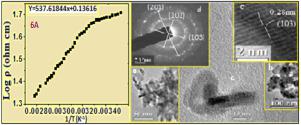Nano-Structures & Nano-Objects Pub Date : 2021-01-04 , DOI: 10.1016/j.nanoso.2020.100651 Sanatan Kr. Nath , P.K. Kalita

|
Coper sulphide nanorods were synthesized in an aqueous solution by a simple chemical route using copper acetate monohydrate and thiourea as reactants in different ambient temperatures with aloe vera as a green capping material. The as prepared nanorods were characterized with XRD, HRTEM, UV–Vis. absorption and PL spectroscopy, FTIR and EDAX analysis. The electrical conductivity of the electrolytic ionic CuS solution was measured by a standard conductivity cell. The XRD confirmed the polycrystalline hexagonal structure of CuS nanorods. The HRTEM exhibited well defined nanorods distributed in large areas. The UV–Vis. absorption and the PL spectra showed a systematic blue shift of absorption and UV-blue emission confirming quantum confinement effect in the synthesized nanorods. Optical band gap as estimated from Tauc-plot increased from 3.0eV to 3.8eV with increase of temperature. The particle sizes calculated from XRD results by Debye–Scherrer and W–H plots are in well agreement with those obtained from HRTEM results. Aloe vera acted as a good green capping material in quantum confinement of nanorods. FTIR spectra exhibited Cu–S stretching peak at 620 cm−1 which is characteristic of CuS. Electrical properties of ionic solution of CuS indicated good semiconducting nature of CuS. Ionic parameters are estimated and correlated to molar concentration. The EDAX analysis confirmed atomic % of copper and sulphur in CuS. The synthesized material may be used in fabrication of an optoelectronic device in UV-blue region.
中文翻译:

芦荟基质中CuS纳米棒的温度依赖性结构,光学和电学性质
通过简单的化学路线,使用乙酸铜一水合物和硫脲作为反应物,在不同的环境温度下,以芦荟作为绿色覆盖材料,通过简单的化学路线在水溶液中合成了硫化铜纳米棒。所制备的纳米棒用XRD,HRTEM,UV-Vis表征。吸收和PL光谱,FTIR和EDAX分析。通过标准电导池测量电解离子型CuS溶液的电导率。XRD证实了CuS纳米棒的多晶六边形结构。HRTEM表现出分布在大面积区域内的定义明确的纳米棒。UV-Vis。吸收和PL光谱显示了吸收和紫外蓝光发射的系统蓝移,证实了合成纳米棒中的量子限制效应。根据Tauc曲线估计的光学带隙从3.0eV增加到3。温度升高时为8eV。由Debye–Scherrer和W–H图从XRD结果计算得出的粒径与从HRTEM结果获得的粒径非常吻合。芦荟在纳米棒的量子限制中充当了良好的绿色覆盖材料。FTIR光谱在620 cm处显示Cu–S拉伸峰-1是CuS的特征。CuS离子溶液的电学性质表明CuS的良好半导体性质。估计离子参数并将其与摩尔浓度相关。EDAX分析证实了CuS中铜和硫的原子%。合成的材料可以用于制造紫外线蓝色区域中的光电器件。











































 京公网安备 11010802027423号
京公网安备 11010802027423号